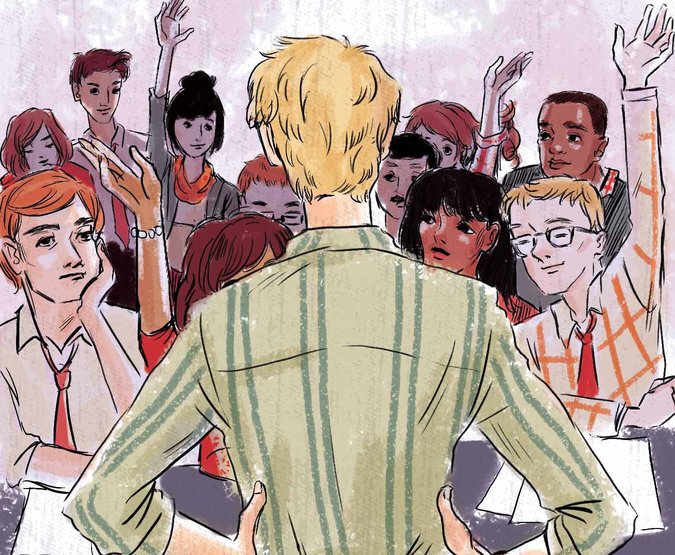Want Teamwork? Encourage Free SpeechAPRIL 12, 2014 Preoccupations By MIKI KASHTAN
Preoccupations By MIKI KASHTAN “Is there anyone who’s not ready for me to sign this contract?”
Jeremy, the chief executive of a small manufacturing company, held up a pen and looked around the room. His core team of 25 stood looking at him. They knew this meant doubling production for a couple of months. No one spoke.
I was positioned a little behind Jeremy, facing the team. As a business consultant, my job is to increase efficiency. I do so by supporting collaboration. Because I am outside the usual power dynamics, I can offer feedback from a different vantage point. I chose to speak into the tense silence: “I don’t know if there is anyone who’s not ready. What I do know is that the way you framed the question, it’s unlikely anyone would feel free to say so.”
I suggested that Jeremy ask a different question: “Does anyone have any concerns they would like addressed before I sign the contract?” This question signals openness and encourages the kind of honesty that is crucial to collaboration.
Sure enough, several hands went up and a lively dialogue ensued. Jeremy addressed almost all of his team’s concerns, and the atmosphere in the room softened. Still, the main item remained: Would the company be able to deliver at a high-enough quality if the customer ordered the maximum amount that the contract allowed? Eventually, after receiving input from his team, Jeremy agreed to reduce the maximum by 25 percent.
The entire meeting lasted only 20 minutes. Instead of dragging their feet to fulfill a plan that had been imposed on them, the team members left the meeting committed to making the contract work. It would be stressful, but because of their active participation, delivering the goods turned from a nightmare to an exciting challenge.
Collaborating to achieve a common goal requires facing dissent. In most workplaces, however, speaking freely is risky. Power differences and habits of passivity lead many people to stay silent. Jeremy’s original question put too much pressure on people to agree, and, if left in place, would have ignored vital considerations.
In the last 14 years, I have worked with dozens of businesses, government agencies and nongovernmental organizations. I have led meetings and taught collaboration in many challenging contexts, whether working amid an acrimonious legislative debate in Minnesota or training a mixed group of Palestinians and Israelis on how to come together when making decisions within their constituencies.
Time and again, I have seen collaboration foster an environment where everyone is free to contribute to their full potential. With this freedom, and with a sense of joint purpose, people willingly stretch in new directions.
Since I co-founded Bay Area Nonviolent Communication in 2002 in Oakland, Calif., my colleagues and I have trained thousands of people on how to collaborate without sacrificing productivity. Sometimes, collaboration requires transforming deep habits of mistrust. At other times, as in the example above, a simple change of words is enough to create a sharp shift.
In my work, I focus on how full ownership of a common purpose increases motivation, how transparency and information-sharing result in wiser choices, and how effective feedback supports learning. More than anything, collaboration works when people know that others, especially those in power, take their suggestions seriously.
This point was driven home to me when I facilitated a series of monthly meetings involving people from multiple locations and levels within a large service agency. When I initially observed one of their meetings, I saw a familiar pattern. The C.E.O. spoke, and spoke again. Some of the other executives also spoke. The middle managers, however, didn’t say much, even when asked questions. Nothing of substance happened, and the group came to no apparent decisions. I wondered how anyone survived these meetings month in and month out.
The first time I ran a meeting, I invited everyone to respond to this question: What would make their meetings work better? I asked each middle manager to speak first, before the executives. I had a significant exchange with almost everyone who spoke; together, we clarified what was most important to them. The managers wanted to trust that they would be taken seriously. They wanted executives to consult with them before making decisions. And they wanted to know when decisions would change how they worked.
Over time, the managers began to take responsibility for the meetings. They came to trust that the executives would address their concerns. And they offered solutions instead of waiting for those executives to fix everything.
When leaders commit to involving the whole group, organizations are transformed. Although collaboration — or “laboring together” (collaborare in Latin) — isn’t easy, it becomes easier the more we welcome differences and even conflict in service of a larger whole. The results are higher trust, increased productivity and rich creativity.
MIKI KASHTAN is the author of “Spinning Threads of Radical Aliveness: Transcending the Legacy of Separation in our Individual Lives” (Fearless Heart Publications).
